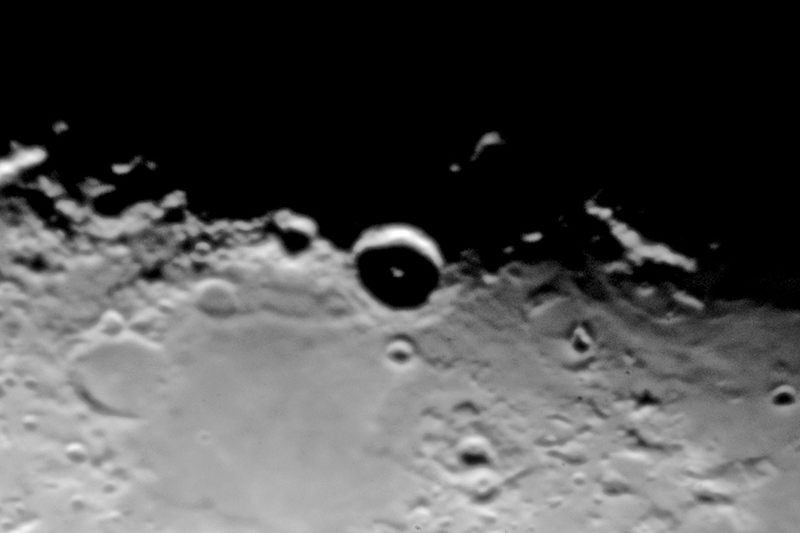
Crater Theophilus at Sunrise, NGC891 Galaxy, NGC2467 Nebula
Posted: 29 January 2012
I opened the observatory, Saturday, 28 January, at 1728 MST, 69°F. There were clouds low along the horizon from the southwest through the north. At 1738 MST, viewed Venus at 77X. It showed a bright gibbous disk. I attempted to image it with the iPhone 4 but it was too bright and overexposed, even with a moon filter. I even tried recording a video using the D7000 DSLR but seeing was too bad; all the frames were badly blurred by atmospheric distortion. At 1803 MST, viewed the moon at 77X and selected the crater Theophilus for high magnification imaging. The sunrise at the crater made an interesting sight and I wanted to try to capture it, even with the bad seeing.
I mounted the D7000 DSLR at prime focus of the 8" and captured this image, 1/320sec, ISO 500:

Theophilus is on the terminator line, near the center of the moon. I then imaged Theophilus at 222X, "Hat Trick", ISO 400. This is a slightly cropped image:

Jupiter, the moon, and Venus made a nice wide grouping in the sky as twilight was fading. I captured this image, f/4.5, 1/15sec, 18mm, ISO 500, at 1834 MST:

At 1835 MST, I unmounted the camera and returned to observing the moon at 77X, 133X, 206X, and 364X. Although seeing was bad, at times the views along the terminator were nice. At 1843 MST, viewed Jupiter at 77X and 133X. Only two moons visible.
At 1852 MST, slewed to NGC891 galaxy, which I planned to image this night once the moon was less a factor. The galaxy became faintly visible at 1908 MST. At 1914 MST, went back to Jupiter. The moon Ganymede was nearing an occultation by the planet and so I monitored it at 133X. The poor seeing made a precise timing of the disappearance of Ganymede difficult, but I estimated it disappeared at 193015 MST. Then only one moon was visible: Callisto. The moon Europa was transiting the planet but was not visible due to the poor seeing.
At 1940 MST, returned to NGC891. I began camera preparations at 2037 MST. I did a focus test on the star Alpha Andromeda using the Bahtinov Mask, and SYNCed on the star. I then slewed back to NGC891 and began a search for a guide star. I found one. At 2059 MST, I did a framing test exposure of NGC891. It was OK so I began waiting for the moon to get lower in the sky. I decided to start imaging at 2130 MST even though the moon was still a slight factor. I didn't want the galaxy to get too low in the sky for good imaging. I did a guided 5 minute exposure but discovered that the focus had shifted. I redid the focus test image and did another 5 minute exposure. But guiding was difficult using the faint guide star I had selected. I looked for a brighter star and found one. I did another framing test exposure. I then did 5 and 10 minute, ISO 6400, guided exposures. This is the 10 minute exposure (full-frame):

At 2214 MST, SYNCed on the star Sirius and slewed to NGC2467, a diffuse nebula. The nebula was visible in the camera viewfinder. I then had to swap the rechargeable batteries in the Wireless AutoStar II handcontroller. I located a guidestar and at 2226 MST, I did a framing test exposure. I then began waiting for the moon to get a little lower in the western sky. At 2250 MST, I did a guided 5 minute, ISO 6400, exposure. I then reframed the nebula in the viewfinder and chose a brighter guide star. This is a slightly cropped, guided, 5 minute, ISO 6400, exposure:

I ended imaging at 2307 MST. I viewed NGC2467, which was nice at 77X.
At 2317 MST, viewed Mars, low in the east, at 77X. The North Polar Ice Cap and one dark area were visible. I tried using 133X but the poor seeing did not allow it.
After six hours in the observatory, I closed the observatory at 2328 MST, 48°F.
Go to the previous report.
Return to the Cassiopeia Observatory Welcome Page.